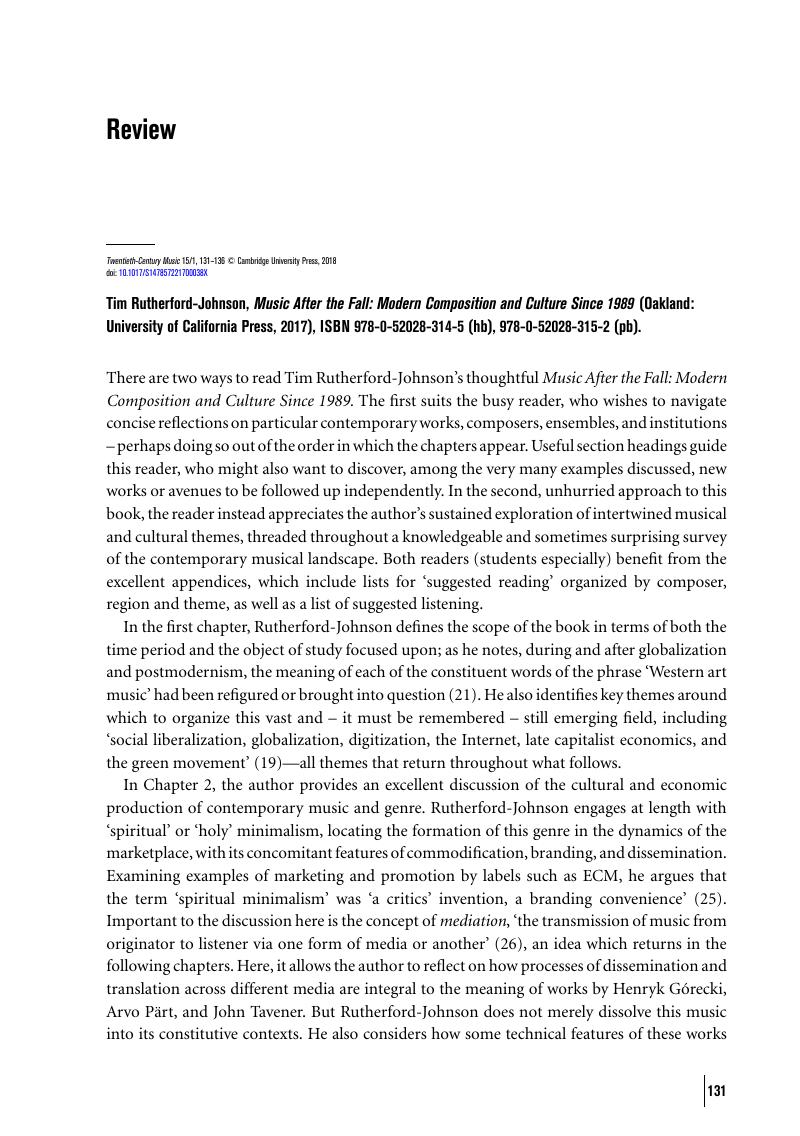No CrossRef data available.
Article contents
Tim Rutherford-Johnson, Music After the Fall: Modern Composition and Culture Since 1989 (Oakland: University of California Press, 2017), ISBN 978-0-52028-314-5 (hb), 978-0-52028-315-2 (pb).
Published online by Cambridge University Press: 26 April 2018
Abstract

- Type
- Reviews
- Information
- Twentieth-Century Music , Volume 15 , Special Issue 1: Special Issue: Spectral Thinking , February 2018 , pp. 131 - 136
- Copyright
- Copyright © Cambridge University Press, 2018
References
1 See Kramer, Jonathan D., ‘Bernard Rands's . . . Body and Shadow . . . : Modernist, Postmodernist, or Antimodernist’, Contemporary Music Review 20/4 (2001), 29–43CrossRefGoogle Scholar.
2 Williams, Alastair, Music in Germany since 1968 (Cambridge: Cambridge University Press, 2013), 231CrossRefGoogle Scholar.
3 See Boym, Svetlana, The Future of Nostalgia (New York: Basic Books, 2001)Google Scholar. To summarize briefly: restorative nostalgia rectifies aspects of an imagined past, reflective nostalgia meditates critically on them. For a discussion of implications for musical modernism of Boym's thinking, see Wilson, Samuel, ‘Valentin Silvestrov and the Symphonic Monument in Ruins’, in Transformations of Musical Modernism, ed. Johnson, Julian and Guldbrandsen, Erling E. (Cambridge: Cambridge University Press, 2015), 201–20CrossRefGoogle Scholar.
4 Critical reflection on individuality and postmodernism is pronounced in the work of social theorist Zygmunt Bauman, which Rutherford-Johnson draws on in later chapters. See, for example, Bauman's The Individualized Society (Cambridge: Polity Press, 2001).
5 See Jarman, Freya, ‘Relax, Feel Good, Chill Out: The Affective Distribution of Classical Music’, in Sound, Music, Affect: Theorizing Sonic Experience, ed. Biddle, Ian and Thompson, Marie (New York: Bloomsbury, 2013), 183–204.Google Scholar
6 Jameson, Fredric, Postmodernism, or, the Cultural Logic of Late Capitalism (London: Verso, 1991).Google Scholar Disjunct to Jameson's characterization of the surface nature of the postmodernism, Rutherford-Johnson also suggests that postmodernism, in often evoking the past, encourages a ‘deeper historical awareness’ (211).
7 See Bauman, Zygmunt, Liquid Modernity (Cambridge: Polity, 2000)Google Scholar; Bourriaud, Nicolas, The Radicant (New York: Lukas and Sternberg, 2009)Google Scholar. Bauman's concept of liquid modernity is in many ways an underdeveloped concept in music studies, with some headway being made by those such as Anthony Gritten. See, for example, his ‘Resonant Listening’, Performance Research, 15/3 (2010), 115–22.
8 See, for instance, Johnson's discussion of Ferneyhough's Carceri d'invenzione, in Out of Time: Music and the Making of Modernity (Oxford: Oxford University Press, 2015), 137–8.
9 Jack Sheen and Matthew Sergeant, ‘Interview with Matthew Sergeant’, www.ddmmyyseries.com/Interview-with-Matthew-Sergeant (accessed 9 June 2017).
10 Silvestrov is incorrectly referred to as Russian in an earlier chapter (59).




